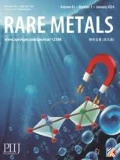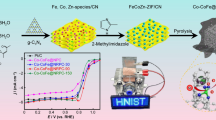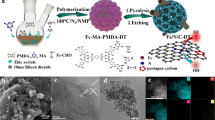Abstract
The rational exploitation of non-precious metal catalyst with high activity, strong durability and low cost for the oxygen reduction reaction (ORR) and oxygen evolution reaction (OER) is of vital importance for metal–air batteries. Herein, a composite of Co3O4 nanoparticles confined in three-dimensional (3D) N-doped porous carbon (Co-NpCs) was prepared by a simple freeze-drying and in situ pyrolysis method. The effect of different dosages of Co(NO3)2 on the catalytic performance was discussed. The Co-NpC-12% exhibits the best catalytic performance (E1/2 = 0.78 V, better stability than 20% Pt/C) in ORR and in OER among all the as-synthesized samples. Furthermore, it also exhibits the best bifunctional activity (ΔE = 0.849 V). The excellent properties of Co-NpCs are mainly due to the synergy between Co3O4 and carbon. Firstly, a high Co3O4 loading amount can boost the defect level of the N-doped hierarchical porous carbon and expose more active sites. Secondly, the unique in situ pyrolysis guarantees a large-area contact between Co3O4 and carbon as well as a strong C–O–Co bonding, which promotes charge transfer, avoids the peeling of Co3O4 nanoparticles and effectively improves the stability of the material. This work is expected to offer a feasible strategy to produce metal oxide/carbon nanocomposite and push forward the development of bifunctional electrocatalyst with high activity and stability.
Graphic Abstract









Similar content being viewed by others
References
Song F, Bai LC, Moysiadou A, Lee S, Hu C, Liardet L, Hu X. Transition metal oxides as electrocatalysts for the oxygen evolution reaction in alkaline solutions: an application-inspired renaissance. J Am Chem Soc. 2018;140(25):7748.
Tahir M, Pan L, Idrees F, Zhang XW, Wang L, Zou JJ, Wang ZL. Electrocatalytic oxygen evolution reaction for energy conversion and storage: a comprehensive review. Nano Energy. 2017;37:136.
Huang ZF, Wang J, Peng YC, Jung CY, Fisher A, Wang X. Design of efficient bifunctional oxygen reduction/evolution electrocatalyst: recent advances and perspectives. J Am Chem Soc. 2017;7(23):1700544.
Liu QF, Pan ZF, Wang E, An L, Sun GQ. Aqueous metal–air batteries: fundamentals and applications. Energy Storage Mater. 2020;27:478.
Xu XL, San Hui K, Dinh DA, Hui KN, Wang H. Recent advances in hybrid sodium–air batteries. Mater Horiz. 2019;6(7):1306.
Meng FL, Zhong HX, Bao D, Yan JM, Zhang XB. In situ coupling of strung Co4N and intertwined N–C fibers toward free-standing bifunctional cathode for robust, efficient, and flexible Zn–air batteries. J Am Chem Soc. 2016;138(32):10226.
Wang X, Liao ZQ, Fu YB, Neumann C, Turchanin A, Nam G, Zschech E, Cho J, Zhang J, Feng XL. Confined growth of porous nitrogen-doped cobalt oxide nanoarrays as bifunctional oxygen electrocatalysts for rechargeable zinc–air batteries. Energy Storage Mater. 2020;26:157.
Meng FL, Liu KH, Zhang Y, Shi MM, Zhang XB, Yan JM, Jiang Q. Recent advances toward the rational design of efficient bifunctional air electrodes for rechargeable Zn–air batteries. Small. 2018;14(32):1703843.
Yao YC, Hu SL, Chen WX, Huang ZQ, Wei WC, Yao T, Liu RR, Zang KT, Wang XQ, Wu G. Engineering the electronic structure of single atom Ru sites via compressive strain boosts acidic water oxidation electrocatalysis. Nat Catal. 2019;2(4):304.
Liu ML, Zhao ZP, Duan XF, Huang Y. Nanoscale structure design for high-performance Pt-based ORR catalysts. Adv Mater. 2019;31(6):1802234.
Wang LP, Shen QX, Tian L, Yang N, Xie G, Li B. Preparation of PtCo composite nanowires and characterization of electrocatalytic performance for oxygen reduction reaction. Chin J Rare Met. 2019;43(4):367.
Guo ZY, Wang FM, Xia Y, Li JL, Tamirat AG, Liu YG, Wang L, Wang YG, Xia YY. In situ encapsulation of core–shell-structured Co@Co3O4 into nitrogen-doped carbon polyhedra as a bifunctional catalyst for rechargeable Zn–air batteries. J Mater Chem A. 2018;6(4):1443.
Li JC, Hou PX, Cheng M, Liu C, Cheng HM, Shao MH. Carbon nanotube encapsulated in nitrogen and phosphorus co-doped carbon as a bifunctional electrocatalyst for oxygen reduction and evolution reactions. Carbon. 2018;139:156.
Han XP, Wu XY, Zhong C, Deng YD, Zhao NQ, Hu WB. NiCo2S4 nanocrystals anchored on nitrogen-doped carbon nanotubes as a highly efficient bifunctional electrocatalyst for rechargeable zinc–air batteries. Nano Energy. 2017;31:541.
Hong WT, Risch M, Stoerzinger KA, Grimaud A, Suntivich J, Shao-Horn Y. Toward the rational design of non-precious transition metal oxides for oxygen electrocatalysis. Energy Environ Sci. 2015;8(5):1404.
Zhao S, Rasimick B, Mustain W, Xu H. Highly durable and active Co3O4 nanocrystals supported on carbon nanotubes as bifunctional electrocatalysts in alkaline media. Appl Catal B Environ. 2017;203:138.
Qiao MF, Wang Y, Li L, Hu GZ, Zou GA, Mamat X, Dong YM. Self-templated nitrogen-doped mesoporous carbon decorated with double transition-metal active sites for enhanced oxygen electrode catalysis. Rare Met. 2020;39(7):824.
Zhang XP, Dong CL, Diao ZD, Lu YR, Shen SH. Identifying the crystal and electronic structure evolution in tri-component transition metal oxide nanosheets for efficient electrocatalytic oxygen evolution. EcoMat. 2019;1(1):e12005.
Tang YP, Jing F, Xu ZX, Zhang F, Mai YY, Wu DQ. Highly crumpled hybrids of nitrogen/sulfur dual-doped graphene and Co9S8 nanoplates as efficient bifunctional oxygen electrocatalysts. ACS Appl Mater Interfaces. 2017;9(14):12340.
Wang M, Dong CL, Huang YC, Shen SH. Operando spectral and electrochemical investigation into the heterophase stimulated active species transformation in transition-metal sulfides for efficient electrocatalytic oxygen evolution. ACS Catal. 2020;10(3):1855.
Lu Q, Yu J, Zou XH, Liao KM, Tan P, Zhou W, Ni M, Shao ZP. Self-catalyzed growth of Co,N-codoped CNTs on carbon-encased CoSx surface: a noble-metal-free bifunctional oxygen electrocatalyst for flexible solid Zn–air batteries. Adv Funct Mater. 2019;29(38):1904481.
Li XX, Zhu PY, Li Q, Xu YX, Zhao Y, Pang H. Nitrogen-, phosphorus-doped carbon–carbon nanotube CoP dodecahedra by controlling zinc content for high-performance electrocatalytic oxygen evolution. Rare Met. 2020;39:680.
Gabe A, García-Aguilar J, Berenguer-Murcia Á, Morallón E, Cazorla-Amorós D. Key factors improving oxygen reduction reaction activity in cobalt nanoparticles modified carbon nanotubes. Appl Catal B Environ. 2017;217:303.
Ma TY, Dai S, Jaroniec M, Qiao SZ. Metal–organic framework derived hybrid Co3O4–carbon porous nanowire arrays as reversible oxygen evolution electrodes. J Am Chem Soc. 2014;136(39):13925.
Liang YY, Li YG, Wang HL, Zhou JG, Wang J, Regier T, Dai H. Co3O4 nanocrystals on graphene as a synergistic catalyst for oxygen reduction reaction. Nat Mater. 2011;10(10):780.
Kumar K, Canaff C, Rousseau J, Arrii-Clacens S, Napporn TKW, Habrioux AL, Kokoh KB. Effect of the oxide-carbon heterointerface on the activity of Co3O4/NRGO nanocomposites toward ORR and OER. J Phys Chem C. 2016;120(15):7949.
Lu XY, Chan HM, Sun CL, Tseng CM, Zhao C. Interconnected core–shell carbon nanotube–graphene nanoribbon scaffolds for anchoring cobalt oxides as bifunctional electrocatalysts for oxygen evolution and reduction. J Mater Chem A. 2015;3(25):13371.
Li XZ, Fang YY, Lin XQ, Tian M, An XC, Fu Y, Li R, Jin J, Ma JT. MOF derived Co3O4 nanoparticles embedded in N-doped mesoporous carbon layer/MWCNT hybrids: extraordinary bi-functional electrocatalysts for OER and ORR. J Mater Chem A. 2015;3(33):17392.
Fu Y, Yu HY, Jiang C, Zhang TH, Zhan R, Li XW, Li JF, Tian JH, Yang RZ. NiCo alloy nanoparticles decorated on N-doped carbon nanofibers as highly active and durable oxygen electrocatalyst. Adv Funct Mater. 2018;28(9):1705094.
Gao H, Yue HH, Qi F, Yu B, Zhang WL, Chen YF. Few-layered ReS2 nanosheets grown on graphene as electrocatalyst for hydrogen evolution reaction. Rare Met. 2018;37(12):1014.
Wang JB, Fan ML, Tu WM, Chen K, Shen YF, Zhang HN. In situ growth of Co3O4 on nitrogen-doped hollow carbon nanospheres as air electrode for lithium–air batteries. J Alloys Compd. 2019;777:944.
Wang Z, Ang JM, Liu J, Ma XYD, Kong JH, Zhang YF, Yan T, Lu XH. FeNi alloys encapsulated in N-doped CNTs-tangled porous carbon fibers as highly efficient and durable bifunctional oxygen electrocatalyst for rechargeable zinc-air battery. Appl Catal B Environ. 2020;263:118344.
Jiang H, Wang YQ, Hao JY, Liu YS, Li WZ, Li J. N and P co-functionalized three-dimensional porous carbon networks as efficient metal-free electrocatalysts for oxygen reduction reaction. Carbon. 2017;122:64.
Li C, Wu MC, Liu R. High-performance bifunctional oxygen electrocatalysts for zinc-air batteries over mesoporous Fe/Co–NC nanofibers with embedding FeCo alloy nanoparticles. Appl Catal B Environ. 2019;244:150.
Sun JT, Yang YK, Wang J, Zhang ZH, Guo JJ. In-situ construction of cobalt oxide/nitrogen-doped porous carbon compounds as efficient bifunctional catalysts for oxygen electrode reactions. J Alloys Compd. 2020;827:154308.
Lai LF, Potts JR, Zhan D, Wang L, Poh CK, Tang CH, Gong H, Shen ZX, Lin JY, Ruoff RS. Exploration of the active center structure of nitrogen-doped graphene-based catalysts for oxygen reduction reaction. Energy Environ Sci. 2012;5(7):7936.
Wu G, Mack NH, Gao W, Ma SG, Zhong RQ, Han JT, Baldwin JK, Zelenay P. Nitrogen-doped graphene–rich catalysts derived from heteroatom polymers for oxygen reduction in nonaqueous lithium–O2 battery cathodes. ACS Nano. 2012;6(11):9764.
Greco C, Cosentino U, Pitea D, Moro G, Santangelo S, Patanè S, D’arienzo M, Fiore M, Morazzoni F, Ruffo R. Role of the carbon defects in the catalytic oxygen reduction by graphite nanoparticles: a spectromagnetic, electrochemical and computational integrated approach. Phys Chem Chem Phys. 2019;21(11):6021.
Jin C, Cao XC, Zhang LY, Zhang C, Yang RZ. Preparation and electrochemical properties of urchin-like La0.8Sr0.2MnO3 perovskite oxide as a bifunctional catalyst for oxygen reduction and oxygen evolution reaction. J Power Sources. 2013;241:225.
Anantharaj S, Kundu S. Do the evaluation parameters reflect intrinsic activity of electrocatalysts in electrochemical water splitting? ACS Energy Lett. 2019;4(6):1260.
Li RC, Hu BH, Yu TW, Chen HX, Wang Y, Song SQ. Insights into correlation among surface–structure–activity of cobalt-derived pre-catalyst for oxygen evolution reaction. Adv Sci. 2020;7(5):1902830.
Fu GT, Cui ZM, Chen YF, Li YT, Tang YW, Goodenough JB. Ni3Fe–N doped carbon sheets as a bifunctional electrocatalyst for air cathodes. Adv Energy Mater. 2017;7(1):1601172.
Bergmann A, Martinez-Moreno E, Teschner D, Chernev P, Gliech M, De Araújo JF, Reier T, Dau H, Strasser P. Reversible amorphization and the catalytically active state of crystalline Co3O4 during oxygen evolution. Nat Commun. 2015;6:8625.
Jiang HL, He Q, Zhang YK, Song L. Structural self-reconstruction of catalysts in electrocatalysis. Acc Chem Res. 2018;51(11):2968.
Li YB, Zhong C, Liu J, Zeng XQ, Qu SX, Han XP, Deng YD, Hu WB, Lu J. Atomically thin mesoporous Co3O4 layers strongly coupled with N–rGO nanosheets as high-performance bifunctional catalysts for 1D knittable zinc–air batteries. Adv Mater. 2018;30(4):1703657.
Liu Q, Wang YB, Dai LM, Yao JN. Scalable fabrication of nanoporous carbon fiber films as bifunctional catalytic electrodes for flexible Zn–air batteries. Adv Mater. 2016;28(15):3000.
Cai SC, Meng ZH, Tang HL, Wang Y, Tsiakaras P. 3D Co–N-doped hollow carbon spheres as excellent bifunctional electrocatalysts for oxygen reduction reaction and oxygen evolution reaction. Appl Catal B Environ. 2017;217:477.
Aijaz A, Masa J, Rösler C, Xia W, Weide P, Botz AJ, Fischer RA, Schuhmann W, Muhler M. Co@Co3O4 encapsulated in carbon nanotube-grafted nitrogen-doped carbon polyhedra as an advanced bifunctional oxygen electrode. Angew Chemie Int Ed. 2016;55(12):4087.
Cheng H, Li ML, Su CY, Li N, Liu ZQ. Cu–Co bimetallic oxide quantum dot decorated nitrogen-doped carbon nanotubes: a high-efficiency bifunctional oxygen electrode for Zn–air batteries. Adv Funct Mater. 2017;27(30):1701833.
Acknowledgements
This work was financially supported by the National Natural Science Foundation of China (Nos. 51871046, 51902046, 51874079, 51571054, 51771046 and 51674068), the Natural Science Foundation of Liaoning Province (No. 201602257), the Natural Science Foundation of Hebei Province (Nos. E2019501097, E2018501091 and E2020501004) and the Fundamental Research Funds for the Central Universities (Nos. N182304017, N182304015, N172302001 and N172304044).
Author information
Authors and Affiliations
Corresponding authors
Electronic supplementary material
Below is the link to the electronic supplementary material.
Rights and permissions
About this article
Cite this article
Wang, ZY., Jiang, SD., Duan, CQ. et al. In situ synthesis of Co3O4 nanoparticles confined in 3D nitrogen-doped porous carbon as an efficient bifunctional oxygen electrocatalyst. Rare Met. 39, 1383–1394 (2020). https://doi.org/10.1007/s12598-020-01581-4
Received:
Revised:
Accepted:
Published:
Issue Date:
DOI: https://doi.org/10.1007/s12598-020-01581-4




